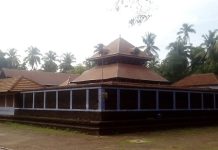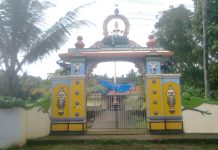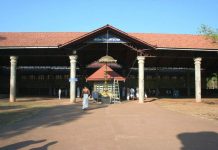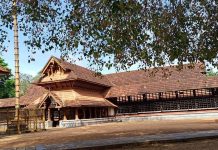
In the vibrant tapestry of India’s temples, each sacred space weaves its own narrative of devotion, traditions, and beliefs. Among these, the Kottankulangara Devi Temple in Kerala stands out as A Unique Temple Tradition. This temple has garnered attention for a practice that challenges traditional gender norms – only men dressed in sarees, emulating women, are allowed entry.
Kottankulangara Devi Temple is dedicated to the powerful goddess Durga Bhagavathy, also known as Aadi Shakthi. The temple is located in the village of Chavara, Kollam district, Kerala, India. The Temple observes the Chamyavilakku festival annually, drawing thousands of male devotees.
Early History of the Kottankulangara Devi Temple:
The temple’s origins hark back to a time when the land it occupies was an untouched forest expanse. Amidst the dense foliage, a serene ambiance prevailed, enriched by towering trees, lush vegetation, and intertwining creepers. The land was blessed with two significant ponds – Bhoothakulam on the northwest, shrouded in local lore as a refuge for venomous snakes, and a vast pond on the eastern side. This latter pond gave rise to a stream during the monsoons, nurturing the surroundings into fertile terrain. This verdant sanctuary drew cowherders from neighboring regions, who congregated with their cattle in this haven of grass and pure water.
Legend of the Kottankulangara Devi Temple:
The temple’s legend weaves a captivating tale of a simple coconut and a stone that bore drops of blood. According to the lore, cowherders discovered a coconut in the vicinity, which led them to a stone near Bhoothakulam’s southern edge. Striking the coconut against the stone to extract its husk, they were astonished to witness drops of blood oozing from the stone. This mysterious occurrence prompted them to share their discovery with the village elders. An astrologer’s counsel affirmed the stone’s supernatural essence, advocating the construction of a temple and immediate initiation of rituals.
The cowherders, embracing an ancient tradition, established a temporary temple using poles, leaves, and tender coconut palm fronds. Adding a unique twist, they adorned themselves in female attire to perform the poojas (rituals). Echoing customs of the past, balikas (young girls) would prepare flower garlands and light pooja lamps in ancestral Kudumba temples. The cowherders emulated this tradition, paying homage to the goddess while wearing feminine attire. They presented offerings that included a milky liquid extracted from coconut kernels, medicinal oil known as Urukku Velichenna, and solid substances (Kottan) as Naivedyam.
Festivals of the Kottankulangara Devi Temple:
Kottankulangara Chamayavilakku
The Kottankulangara Festival, popularly known as Kottankulangara Chamayavilakku, holds a special place during the 10th and 11th days of the Malayalam Meenam Maasam. On these special festival days, the temple draws thousands of devotees seeking the blessings of Goddess Bhagavathy. What makes this festival truly captivating is the unique practice of men adorning themselves in various styles of female attire. From traditional set sarees to elegant pattu sarees, and even dance costumes, the spectrum of clothing choices adds to the festive spirit of this extraordinary event.
As night descends, these devotees, adorned in their transformed appearance, illuminate the path with traditional lamps. They proceed in a procession accompanied by the rhythmic strains of a traditional orchestra, paying homage to the goddess and seeking her blessings.
Kuruthola Pandal
To commemorate the temple’s origin tale, devotees construct a model of the ancient temple every year. This reconstruction, known as Kuruthola Pandal, evokes spiritual joy and an abiding sense of comfort among the faithful. Witnessing the temple’s deity embark on a symbolic journey from Kunjalummoodu to Arattukadavu during the festival fills devotees with a profound sense of solace.
Jeevatha Ezhunnallathu
The Jeevatha Ezhunnallathu tradition, commonly practiced in Devi temples, involves participants donning traditional attire and carrying the Jeevatha – a ceremonial structure – on their shoulders. The step-dance performed during this ritual reenacts the goddess’s visit to her devotees, symbolizing their offerings of Anpara (six measures of rice) and Ezhu para (seven measures of rice) for her blessings.
How to Reach the Kottankulangara Devi Temple:
By Air:
The nearest major airport is Thiruvananthapuram International Airport (TRV). Situated approximately 73 kilometers away, this airport serves as a gateway to the region. From Thiruvananthapuram, travelers can opt for taxis, buses, or other modes of transportation to complete the journey to the temple.
By Train:
Train travel enthusiasts can also make their way to the Kottankulangara Temple. While the nearest station is Kaunagapally, it’s important to note that not all trains have scheduled stops here. A more viable option is to head to Kollam Junction (QLN), which offers better connectivity. From there, buses, taxis, and other local transportation options can be availed to reach the temple.
By Bus or Road:
For those who prefer road travel, buses and private vehicles offer a flexible and accessible means of reaching the temple. The Kottankulangara Temple is located beside NH-4, making it easily accessible by road. Buses frequently ply this route, and visitors can catch buses bound for Kollam or Trivandrum, with many of them passing directly in front of the temple. Additionally, if you’re traveling from either Kollam or Karunagappally, both cities are well-connected by road, ensuring a smooth journey.


























































